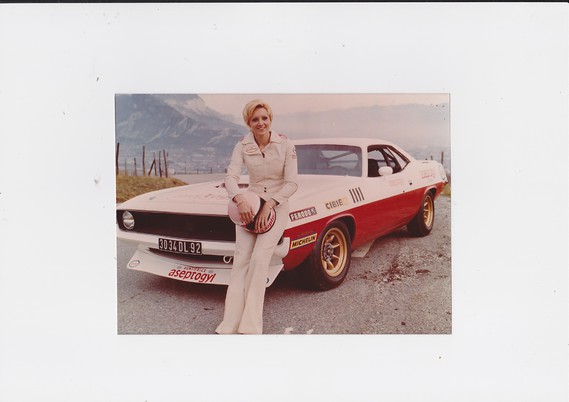The Kimber-Smith/Cowell Corolla in 1987
Barbara
raced in the British Touring Car Championship in 1988 and 1989.
The
first award she won in the world of motorsport was a first place in a fancy
dress car parade at Long Eaton stock car track, in 1973. Barbara dressed up as
a mermaid on a car sheeted up as rocks, next to driver Tony Allen, who was
Neptune.
The
Long Eaton track was the scene of her first driving exploits, too, as a junior
driver in Ministox. She progressed through the junior and senior ranks, and by
1978, when she was twenty, she was the British Mini-Rod champion. Three years
later, in 1981, she was British, European and World Mini-Rod champion.
As she
had won almost everything she could in short-oval Mini-Rods, it was a natural
progression into long circuit racing in a Mini in 1982. She entered the Mini Seven
championship, and was eleventh overall in her first year. This was enough to
earn her the Novices award.
In
1983, she moved steadily up the Mini racing ranks, and ended the year as the
Lydden Hill Mini Seven champion. In 1984, she was second in the overall
championship, winning herself the BWRDC’s Embassy Trophy, and their Racing championship
trophy.
For the
next few seasons, Barbara raced different cars in the Uniroyal Production
Saloon championship. She received support from Gerry Marshall, who prepared her
Fiat Strada in 1985, and later provided her with a Vauxhall Astra GTE. She
enjoyed some success in these cars, but it was in a Suzuki Swift that she
really shone, winning Class D in 1987 with five victories. This gave her second
overall in the championship. One of her wins was a two-driver enduro at the end
of the season, at Brands Hatch, and she shared the car with Geoff Kimber-Smith.
In September, the same driver pairing tackled the Tourist Trophy at
Silverstone, a round of the International Touring Car Championship. They drove
a Toyota Corolla, but did not finish.
Following
on from her Production Saloon wins and ITC experience, it was a logical step
for Barbara to test herself further in the British Touring Car Championship.
Her 1988
BTCC season started with the two-driver enduro at Donington, sharing Geoff
Kimber-Smith’s Toyota Corolla again. They were fourteenth overall, and won
their class. Later in the season, she used a Ford Escort RS1600i run by the North
Essex Motorsport team. She was 19th in the Brands Hatch 1000km
support race, second in class, but then did not make it to the finish at
Snetterton or Brands. She did not qualify for the Birmingham Superprix street
race, but it was cancelled anyway, but then the same happened at Donington. In
the last race of the season, at Silverstone, she was 18th overall.
That
year, she also found time for some Production Saloon races, in a BMW M3. Her
best result seems to have been a class win at Castle Combe.
In
1989, she renewed her partnership with Kimber-Smith and the Corolla for one
race, at Donington, but did not finish due to a misfire. Illness limited her
activities this year, and it was her only BTCC race.
After
1989, she raced less, but she remained competitive in Production Saloons. She
took a year off in 1990 to set up a performance driving school, and to marry
Peter Babbage. Now competing as Barbara Babbage, she raced the Swift again in
1991, achieving some more top-ten overall finishes.
In
1993, she raced in the Willhire 24 Hours in a Honda Civic. She was part of an
all-female team with Clare Redgrave and Kirsten Kolby. They were fourth. They
apparently took part in two other enduros that year, with similar success, but
the results are not forthcoming.
In
either 1993 or 1994, she raced a Peugeot 106 in Production Saloons, scoring at
least one second place at Silverstone. 1994 was her last season; it was
becoming increasingly difficult for Barbara to find the sponsorship needed to
compete at a level of which she was capable. She retired and started a family.
In 1994, she became one of the first women to be given full membership of the
British Racing Drivers’ Club.
(Image
from http://www.ae86drivingclub.com.au/forums)







